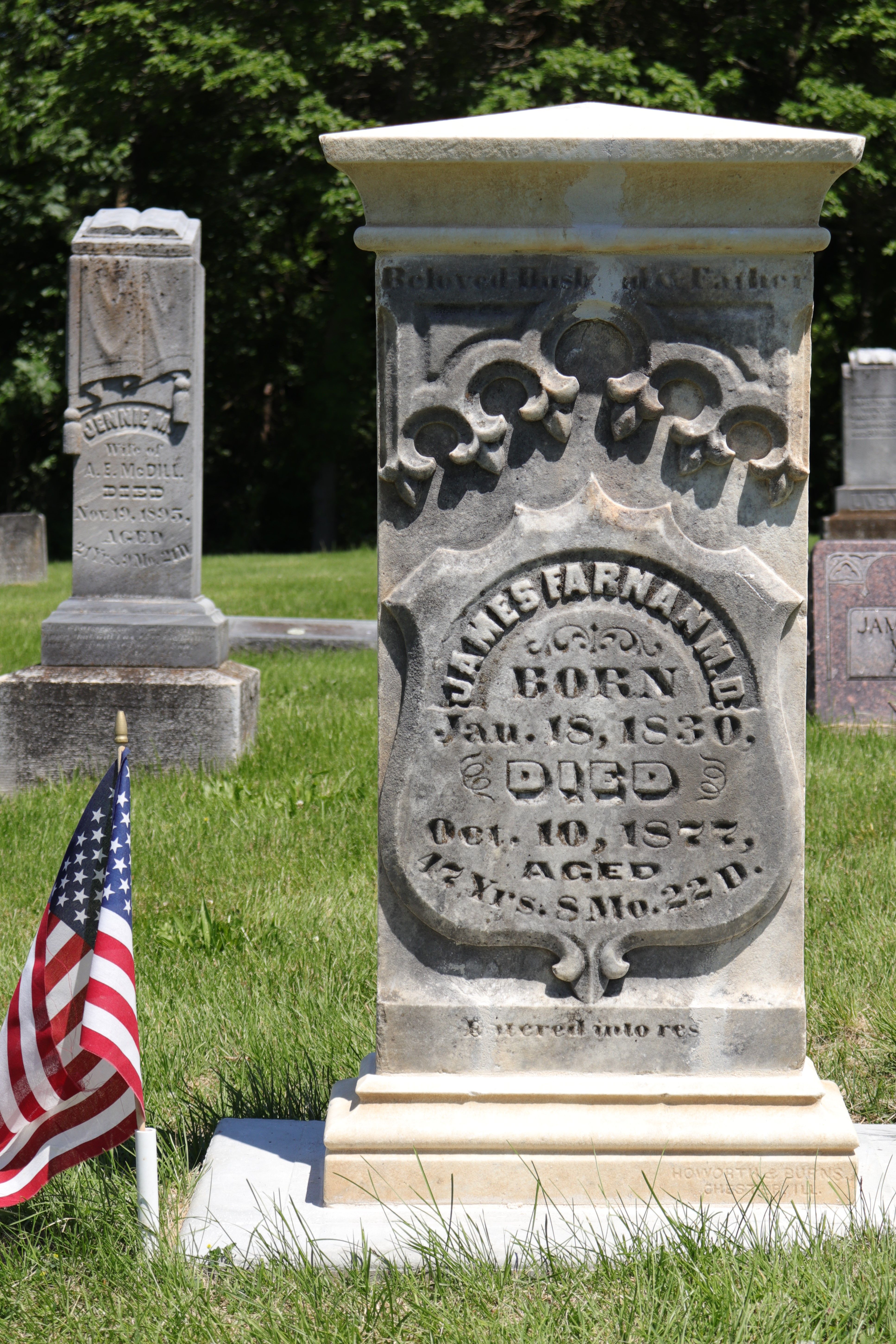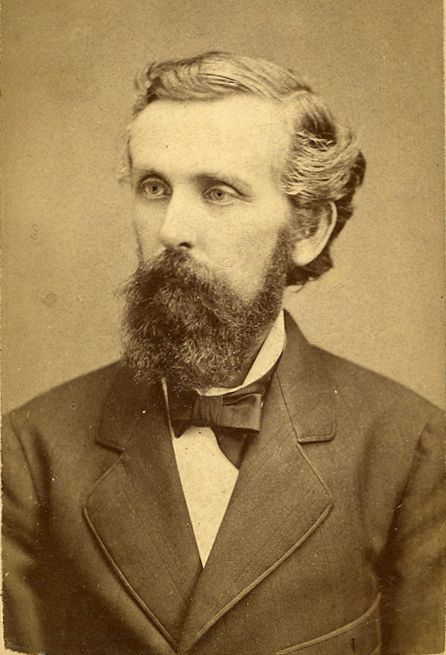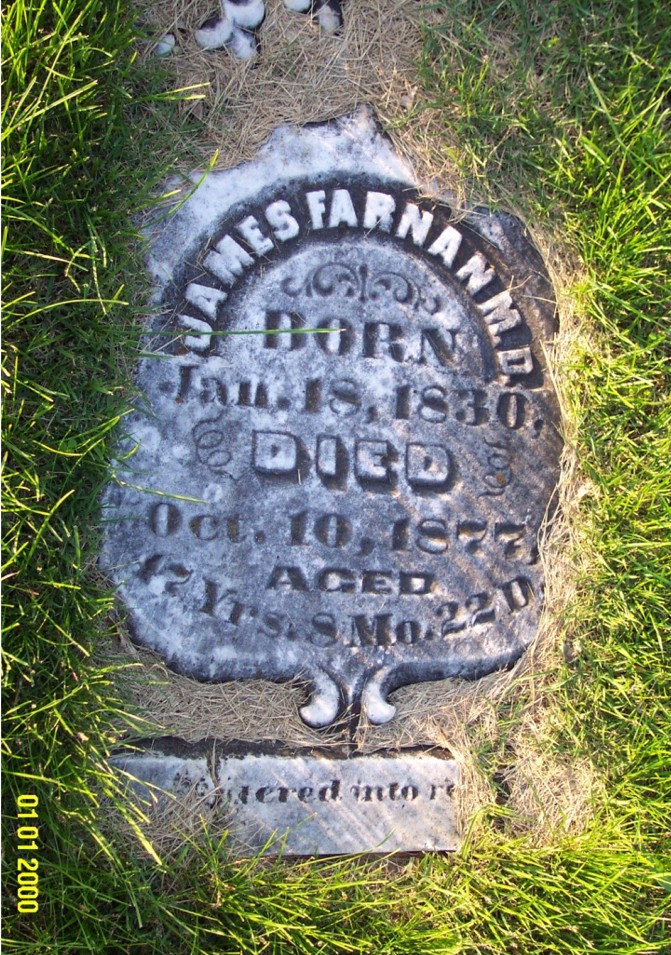James Farnan, M.D. (1830-1877) Major in Co. K 5th Illinois Calvary
James Farnan was one of eight children born to John Farnan and Annie Beatagh, in County Navan of Meath, Ireland. The family immigrated to the United States in about 1838, when James was 8 years old, first settling in the east and then moving to Randolph County, Illinois about 1840 as farmers. James left home at age 14 and spent 3 years at sea on a Man-of-War, traveling the world. He landed in California in 1849 for the Gold Rush and then returned to Randolph Co. in 1851. He next attended St. Louis Medical College and graduated in 1853, setting up practice in Sparta.
In that same year, he married Harriet McDill (1829-1872), the daughter of Rev. David McDill (1791-1870) and Lydia McDaniels McDill (1795-1873), prominent citizens of Sparta and a United Presbyterian minister. Harriet and James would have 5 children before she passed away in 1872.
During the marriage, the Civil War broke out and James enlisted in the 5th CAV, Co. K as a Capt., mustering in at Camp Butler, Nov 21, 1861 for a 3-year tour. He also enlisted his younger 15-year-old brother, John F. Farnan as bugler in Company K. John was discharged as disabled one year later in Oct 1862. In July of 1862, James was promoted to Major leading a number of forays and sorties throughout Arkansas and Mississippi. He was not of the medical corps in spite of his medical degree and experience. The men of the 5th CAV were stationed in the eastern Arkansas area for nearly a year, in swampy, miasmic, disease-ridden conditions. The men suffered greatly from malaria, dysentery, bronchitis, pneumonia, cholera, measles, typhoid, and an assortment of debilitating conditions acerbated by near-starvation, contaminated water and poor sanitation. Large numbers of men died due to disease. James fought under Generals Grant (Vicksburg), McPherson, Logan and Sherman before he contracted a chronic diarrhea condition. He left on a medical furlough, petitioned for disability, did not receive it and so resigned in Sep 1864. Several historical notes refer to some difficulties in his leadership capacity which may have been another factor in quitting. He returned to Sparta and his medical practice. For details of the regimental history, refer to http://civilwar.illinoisgenweb.org/dyers/cav-005.html and below.
Dr. Farnan was a well-known figure in Sparta, as a Republican, a Presbyterian, President of the School Board and a member of the local Board of Health. Harriet died 6 years after his return from the war and he married Henriette Gass, daughter of John Gass from St. Louis in 1873. Henriette was a teacher and school principal. They may have met while he was in medical college in St. Louis. The couple were married only 4 years when James died suddenly in 1877. Henriette stayed in the Sparta area for a few years and then it is thought she returned to St. Louis. There were no children during their marriage. John was buried in Union Cemetery with Harriet and their toddler daughter Lydia. Nearby In Union Cemetery are some of his fellow veterans with whom he had fought in the 5th Cavalry.
Other Company K 5th CAV soldiers in Union Cem.: Gordon brothers: James and A.J., James R. Maxwell, J.T. Louther, John C. McHenry, George McKee, John B. Rigdon, and Edwin Shannon.
OVERVIEW:
Organized at Camp Butler, Ills., August 31 to December 30, 1861. Moved to Benton Barracks, Mo., February 20, 1862. Thence to Pilot Knob, Mo., March 3. Moved to Doniphan March 27-April 1 and to Pocahontas April 17. Attached to Steele's Division, Army of Southeast Missouri, to May, 1862. Army of Southwest Missouri to July, 1862. District of Eastern Arkansas, Department of Missouri, to December, 1862. 1st Brigade 3rd (Cavalry) Division, District of Eastern Arkansas, to January, 1863. 1st Brigade, 2nd Cavalry Division, 18th Army Corps, Department of the Tennessee, to April, 1863. 1st Brigade, Cavalry Division, District of Eastern Arkansas, to June, 1863. Cavalry Herron's Division, 13th Army Corps to August, 1863. Winslow's Cavalry Brigade, 15th Army Corps to December, 1863. Winslow's Cavalry Brigade, 17th Army Corps, and District of Vicksburg, Miss., to January, 1865. 1st Brigade, Cavalry Division, District of West Tennessee to June, 1865. Departments of the Gulf and Texas to October, 1865
Researched and authored by Carole Morris Pancake, cemeterist (49421609) 4/26/2022
Kohl, Rhonda M. The Prairie Boys Go To War, The Fifth Ilinois Cavalry, 1861-1865.Southern Illinois University Press. 2013.
1850, 1860, 1870, 1880 U.S. Census
James Farnan, M.D. (1830-1877) Major in Co. K 5th Illinois Calvary
James Farnan was one of eight children born to John Farnan and Annie Beatagh, in County Navan of Meath, Ireland. The family immigrated to the United States in about 1838, when James was 8 years old, first settling in the east and then moving to Randolph County, Illinois about 1840 as farmers. James left home at age 14 and spent 3 years at sea on a Man-of-War, traveling the world. He landed in California in 1849 for the Gold Rush and then returned to Randolph Co. in 1851. He next attended St. Louis Medical College and graduated in 1853, setting up practice in Sparta.
In that same year, he married Harriet McDill (1829-1872), the daughter of Rev. David McDill (1791-1870) and Lydia McDaniels McDill (1795-1873), prominent citizens of Sparta and a United Presbyterian minister. Harriet and James would have 5 children before she passed away in 1872.
During the marriage, the Civil War broke out and James enlisted in the 5th CAV, Co. K as a Capt., mustering in at Camp Butler, Nov 21, 1861 for a 3-year tour. He also enlisted his younger 15-year-old brother, John F. Farnan as bugler in Company K. John was discharged as disabled one year later in Oct 1862. In July of 1862, James was promoted to Major leading a number of forays and sorties throughout Arkansas and Mississippi. He was not of the medical corps in spite of his medical degree and experience. The men of the 5th CAV were stationed in the eastern Arkansas area for nearly a year, in swampy, miasmic, disease-ridden conditions. The men suffered greatly from malaria, dysentery, bronchitis, pneumonia, cholera, measles, typhoid, and an assortment of debilitating conditions acerbated by near-starvation, contaminated water and poor sanitation. Large numbers of men died due to disease. James fought under Generals Grant (Vicksburg), McPherson, Logan and Sherman before he contracted a chronic diarrhea condition. He left on a medical furlough, petitioned for disability, did not receive it and so resigned in Sep 1864. Several historical notes refer to some difficulties in his leadership capacity which may have been another factor in quitting. He returned to Sparta and his medical practice. For details of the regimental history, refer to http://civilwar.illinoisgenweb.org/dyers/cav-005.html and below.
Dr. Farnan was a well-known figure in Sparta, as a Republican, a Presbyterian, President of the School Board and a member of the local Board of Health. Harriet died 6 years after his return from the war and he married Henriette Gass, daughter of John Gass from St. Louis in 1873. Henriette was a teacher and school principal. They may have met while he was in medical college in St. Louis. The couple were married only 4 years when James died suddenly in 1877. Henriette stayed in the Sparta area for a few years and then it is thought she returned to St. Louis. There were no children during their marriage. John was buried in Union Cemetery with Harriet and their toddler daughter Lydia. Nearby In Union Cemetery are some of his fellow veterans with whom he had fought in the 5th Cavalry.
Other Company K 5th CAV soldiers in Union Cem.: Gordon brothers: James and A.J., James R. Maxwell, J.T. Louther, John C. McHenry, George McKee, John B. Rigdon, and Edwin Shannon.
OVERVIEW:
Organized at Camp Butler, Ills., August 31 to December 30, 1861. Moved to Benton Barracks, Mo., February 20, 1862. Thence to Pilot Knob, Mo., March 3. Moved to Doniphan March 27-April 1 and to Pocahontas April 17. Attached to Steele's Division, Army of Southeast Missouri, to May, 1862. Army of Southwest Missouri to July, 1862. District of Eastern Arkansas, Department of Missouri, to December, 1862. 1st Brigade 3rd (Cavalry) Division, District of Eastern Arkansas, to January, 1863. 1st Brigade, 2nd Cavalry Division, 18th Army Corps, Department of the Tennessee, to April, 1863. 1st Brigade, Cavalry Division, District of Eastern Arkansas, to June, 1863. Cavalry Herron's Division, 13th Army Corps to August, 1863. Winslow's Cavalry Brigade, 15th Army Corps to December, 1863. Winslow's Cavalry Brigade, 17th Army Corps, and District of Vicksburg, Miss., to January, 1865. 1st Brigade, Cavalry Division, District of West Tennessee to June, 1865. Departments of the Gulf and Texas to October, 1865
Researched and authored by Carole Morris Pancake, cemeterist (49421609) 4/26/2022
Kohl, Rhonda M. The Prairie Boys Go To War, The Fifth Ilinois Cavalry, 1861-1865.Southern Illinois University Press. 2013.
1850, 1860, 1870, 1880 U.S. Census
Inscription
Beloved Husband & Father
JAMES FARNAN M.D.
BORN
Jan. 18, 1830,
DIED
Oct. 10, 1877,
AGED
47 Yrs. 8Mo. 22D.
Entered unto rest
Family Members
Advertisement
Records on Ancestry
Advertisement









